In today’s fast-changing online world, making money from your website is very important to keep your digital presence growing. Many website owners and publishers have used Google AdSense for a long time to earn money from ads.
It’s easy to use and works well with Google’s system, making it popular, especially for beginners. But even though it’s popular, Google AdSense has some limits. These limits can stop you from earning as much as you want. They may also prevent you from reaching your ad monetization goals.
Many publishers face problems. They are often rejected and experience delayed payments. Difficulties with AdSense account approval and management make many publishers look for more reliable monetization options.
They also face sudden account suspensions and have limited control over ad formats and placements. Because of these issues, more website owners are seeking reliable and higher-paying Google AdSense alternatives. These alternatives offer more flexibility.

They provide better ad quality and advanced ad tech solutions. In particular, high paying AdSense alternatives are gaining attention. These alternatives have the potential to deliver increased earnings compared to Google AdSense. This makes them attractive options for maximizing ad revenue.
This article explores the top 15 AdSense alternatives in 2025. It aims to help website owners improve ad revenue. This is achieved using multiple ad formats, premium advertisers, and programmatic advertising solutions. It also covers advanced header bidding partners.
We will explain why diversifying your revenue streams is good. We will share key points like minimum traffic requirement and ad setup ease. This will boost your advertising revenue. It will also improve user experience on your site.
What is Google AdSense?

Google AdSense is a powerful advertising program. Google manages it and it enables website and blog owners to monetize their content. They do this by displaying targeted ads on their sites. Through this program, advertisers pay to showcase their ads, and publishers earn a share of the revenue generated.
AdSense supports a variety of basic ad formats, including text, image, banner ads, and video ads. These ads are intelligently matched to your site’s niche, content type, and audience interests for maximum relevance.
Using a pay-per-click (PPC) model, website owners receive payments based on the number of valid clicks those ads receive. Best of all, AdSense is free to join. It provides an easy entry point for anyone wanting to earn money from their online presence.
Getting started is simple: apply for AdSense via the official website and ensure your site complies with Google’s policies.
For a smooth approval process, review the updated AdSense approval guide and AdSense policies. After approval, you can access your AdSense account. Place the code provided by Google onto your site. Then you’re ready to start earning.
AdSense is an excellent monetization solution for many publishers, especially:
- Blogs: If you regularly publish high-quality blog posts, AdSense can be an effective way to generate consistent revenue.
- Forums: Forums benefit from community engagement and discussion, both of which attract advertisers and boost AdSense earnings.
- Free Online Tools: Sites offering free tools or services often see strong ad performance, providing another opportunity to maximize earnings.
To boost traffic and revenue from AdSense, focus on optimizing these types of content and experiment with different ad strategies. Targeting high CPC keywords in your site’s content can further increase your ad income potential.
Why Publishers Need AdSense Alternatives in 2025
While Google AdSense pay has long been popular, many publishers face challenges. They deal with strict approval policies and limited ad formats.
Unlike AdSense, many alternatives offer more control. They provide a wider variety of basic ad formats. This helps publishers customize their monetization strategy.
They also experience declining CPM rates and sudden account suspensions. Unlike AdSense, alternative ad networks give website owners more control, higher earnings, and diverse ad types to boost revenue.
By exploring adsense alternatives pay, publishers can reduce dependency on a single network. They can access premium advertisers. This also allows them to offer engaging ad formats like video, native, popunder, and interactive units.
Diversifying ad revenue also allows for advanced optimization strategies, better user experience, and more stable income streams.
With direct advertising networks, publishers can connect with advertisers for premium placements and optimized revenue targeting segmented audiences.
In 2025, using multiple ad networks is essential for publishers. This strategy helps them maximize revenue. It also allows them to maintain control and protect their earnings.
15 Best Google AdSense Alternatives
Discover the top 15 Google AdSense alternatives for 2025 that offer higher payouts, diverse ad formats, and advanced monetization features.
This section highlights a range of ad networks suitable for different traffic levels and niches. It helps publishers optimize ad revenue. It also enhances user experience.
- Premium Tier Networks (High Traffic Required)
- Mid-Tier Networks (Moderate Requirements)
- Accessible Networks (Low Entry Barriers)
- Emerging and Specialized Networks
Premium Tier Networks (High Traffic Required)
These premium ad networks are ideal for high-traffic websites. As a premium ad network, they provide enhanced monetization features.
They offer advanced programmatic advertising and header bidding. Users get access to top demand partners like Google Ad Exchange.
This helps publishers increase ad revenue with diverse ad formats and strong support while maintaining a good user experience.
1. Setupad
Best Adsense alternative and ad network

Setupad is a premium platform that helps publishers earn more from their ads compared to Google AdSense. It uses advanced header bidding. This programmatic advertising technology connects publishers with over 30 top demand partners.
These include Google AdX, OpenX, and Magnite. This real-time bidding process ensures better CPM rates and higher fill rates.
Setupad focuses on user experience by offering fast, lightweight ad scripts that don’t slow down websites. It is best for medium to large publishers with at least 100,000 monthly pageviews.
With transparent reporting and dedicated support, Setupad is a strong alternative to AdSense in 2025.
Features of SetupAds:
- Header bidding technology for maximized competition and CPMs.
- Access to 30+ premium SSPs and demand partners.
- AI-driven ad layout optimization.
- Dedicated account manager for every publisher.
- Real-time reporting dashboard with detailed insights.
- GDPR, CCPA, and privacy-compliant ad serving.
- Lazy loading ads to improve site speed.
- Easy WordPress plugin integration.
- Ad refresh option for higher revenue per session.
- Flexible ad formats including display, video, and native.
Pros
- Higher CPM rates compared to AdSense.
- Access to premium demand partners, not just Google.
- Dedicated support for publishers.
- Advanced analytics and real-time reporting.
- Lightweight and fast ad scripts.
- Strong compliance with privacy laws.
- Supports various ad formats for diversification.
- Easy integration with WordPress and CMS platforms.
- Transparent revenue reporting.
- Great for scaling websites with global traffic.
Cons
- Minimum traffic requirement of ~100,000 pageviews/month.
- Not suitable for small bloggers.
- Revenue share model may not suit everyone.
- Requires technical setup for advanced features.
- Payment delays compared to instant networks.
- Strict publisher approval process.
- Limited to established websites.
- May require placement optimization for best results.
- Higher learning curve for beginners.
- Not ideal for niche blogs with low traffic.
Ad Types & Payouts
- Ad Types: Display, native, video, header bidding ads.
- Payout Details: Minimum payout is €100 (PayPal, Wire Transfer, Wise, Payoneer, Revolut). Payments are made Net-60 (two months after earnings).
2. Ezoic: Best AI-Driven Platform
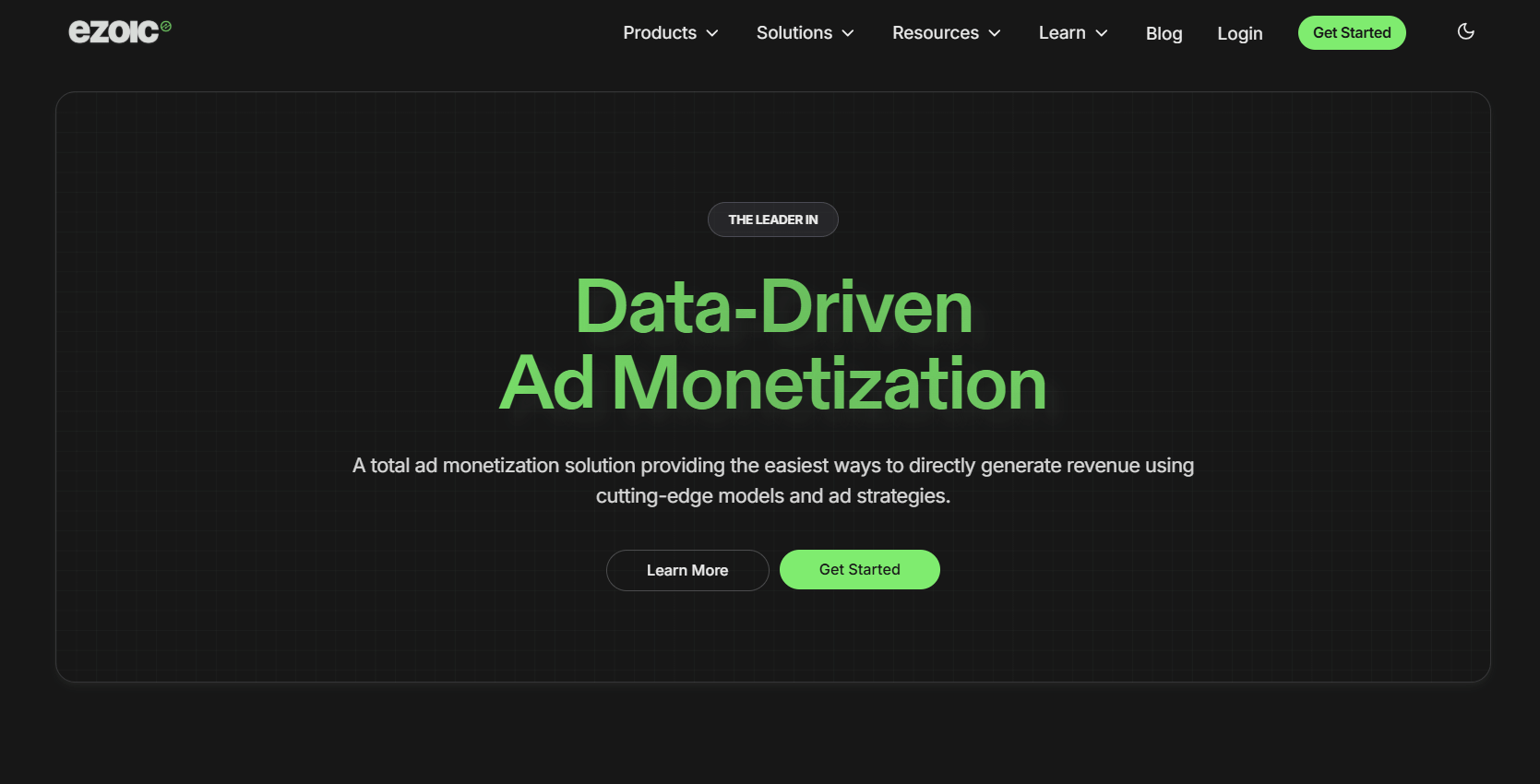
Ezoic is an AI-driven ad optimization platform that works seamlessly as a Google AdSense alternative.
By automating ad testing and placement, Ezoic allows publishers to maximize revenue without compromising user experience. It is compatible with Google AdSense, AdX, and other ad networks, giving flexibility in monetization.
Ezoic’s machine learning analyzes visitor behavior, adjusting ad formats and positions for optimal performance.
Ezoic can outperform AdSense, especially for small publishers with Tier 1 traffic. Ideal for mid-to-high traffic blogs, Ezoic offers detailed analytics, customizable layouts, and support for multiple ad formats.
Its focus on user-friendly ad experiences ensures that publishers can increase revenue while maintaining site quality and engagement.
Features:
- AI-powered ad optimization
- Header bidding integration
- Customizable ad layouts
- Mobile-responsive ads
- Ad testing and experimentation
- Revenue reporting and analytics
- Integration with multiple ad networks
- Page speed monitoring
- Support for video and display ads
- User-friendly dashboard
Pros:
- Higher revenue through AI optimization
- Compatible with AdSense and AdX
- Customizable ad placement
- Detailed analytics and reporting
- Mobile-optimized ads
- Easy WordPress integration
- Supports multiple ad types
- Reduces bounce rate with better UX
- Excellent for medium to high-traffic sites
- Transparent payment system
Cons:
- Learning curve for beginners
- Free plan limited for small sites
- Approval required for low-traffic blogs
- Ad placements may need adjustment
- Setup can be time-consuming
- Premium features may be costly
- Limited control over automated ad decisions
- Ads can affect site speed if not optimized
- Support can be slow for free users
- Not ideal for very low-traffic sites
Ad Types & Payouts
- Ad Type: Display, Video, Native, Mobile
- Payout: Net 30, PayPal/Bank transfer, minimum $20
3. Raptive (formerly AdThrive): Premium Publisher Network

Raptive, formed from the merger of AdThrive and CafeMedia, is a premium ad management network with high traffic requirements.It specializes in lifestyle niches such as food, parenting, travel, and home improvement.
Unlike basic ad networks, Raptive focuses on providing publishers with premium advertisers. It also offers higher CPMs. This ensures better returns on quality content. Raptive provides dedicated account managers.
It also offers personalized support and data-driven ad optimization. This combination offers a professional-level solution for websites ready to scale their ad revenue.
AdThrive focuses on premium publishers, requiring at least 100,000 monthly page views and primarily serving U.S. traffic. However, the high entry requirements make it best suited for established bloggers. This is for those publishers who already attract a strong audience base.
Features:
- Premium advertiser partnerships
- Higher RPMs for lifestyle content
- Dedicated account managers
- Strong brand safety standards
- Personalized ad placement optimization
- Access to advanced analytics
- Customizable ad solutions
- Focus on long-term growth
- Transparent revenue model
- Reliable publisher support
Pros:
- Premium-level advertisers
- Excellent RPMs in lifestyle niches
- Strong support team
- Optimized user experience
- Advanced reporting
- Stable income for large publishers
- Higher fill rates
- Exclusive access to top campaigns
- Long-term growth focus
- Trusted by established publishers
Cons:
- High entry barrier (100K views)
- Strict content standards
- Slower approval process
- Limited to English-speaking countries
- Not suitable for new bloggers
- Delayed setup time
- Focus on certain niches only
- Competitive entry requirements
- Limited testing flexibility
- Revenue share varies by niche
Ad Types & Payout:
- Ad Types: Display, video, native ads
- Payout: NET-45 terms, revenue share model, premium CPMs
Mid-Tier Networks (Moderate Requirements)
Mid-tier ad networks offer a good balance for publishers with moderate traffic, typically between 10,000 and 100,000 monthly page views. These platforms provide a variety of ad formats, access to quality advertisers, and reasonable entry requirements.
They are well-suited for growing websites looking to increase their ad revenue while keeping a positive experience for their visitors.
Features like customizable ad placements, header bidding, and dependable support help publishers get the most from their ads. Below are some of the top mid-tier AdSense alternatives to help boost your earnings without needing a large audience.
4. Media.net – Best for US/UK Traffic
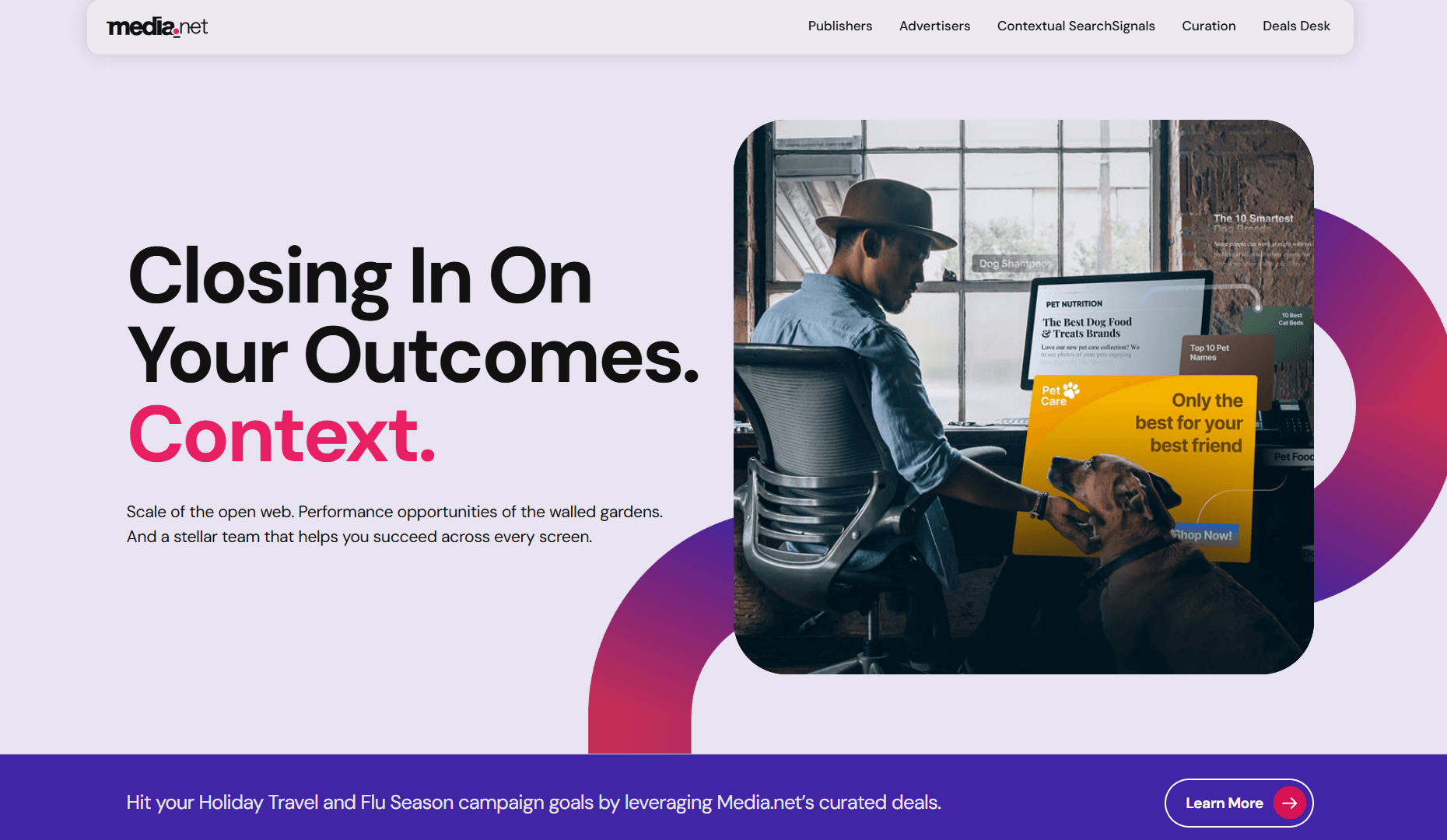
Media.net is one of the largest contextual advertising networks and a direct competitor to AdSense. Powered by Bing and Yahoo, it acts as a native advertising platform. This platform enables publishers to integrate native ads seamlessly into website content.
With its strong focus on premium traffic from the US, UK, and Canada, Media.net is ideal for websites attracting English-speaking audiences. The network provides customizable ad units, mobile optimization, and high ad relevance, ensuring a better user experience.
While approval may take a few days and requires quality content, Media.net is known for its reliable payouts. It has a strong reputation in the industry. This makes it a trusted mid-tier option for many publishers.
Features:
- Contextual ad targeting
- Powered by Bing and Yahoo
- Strong US/UK/Canada focus
- Customizable ad units
- Mobile-optimized ads
- Access to premium advertisers
- Real-time performance tracking
- Easy integration
- High ad relevance
- Reliable payouts
Pros:
- Strong contextual targeting
- Trusted network (Yahoo/Bing)
- High-quality advertisers
- Mobile-friendly ad formats
- Good for English-speaking traffic
- Transparent approval process
- Customizable designs
- Competitive RPMs
- Easy setup
- Good support
Cons:
- Focus on US/UK traffic only
- Manual approval takes time
- Strict content requirements
- $100 payout threshold
- Limited for low-traffic sites
- Lower earnings for non-US traffic
- No instant approval
- Ad units may look repetitive
- Payment NET-30 terms only
- Revenue can fluctuate with traffic quality
Ad Types & Payout:
- Ad Types: Contextual display, native ads
- Payout: $100 minimum, NET-30 via PayPal, wire transfer
5. Mediavine: Lifestyle Content Specialist
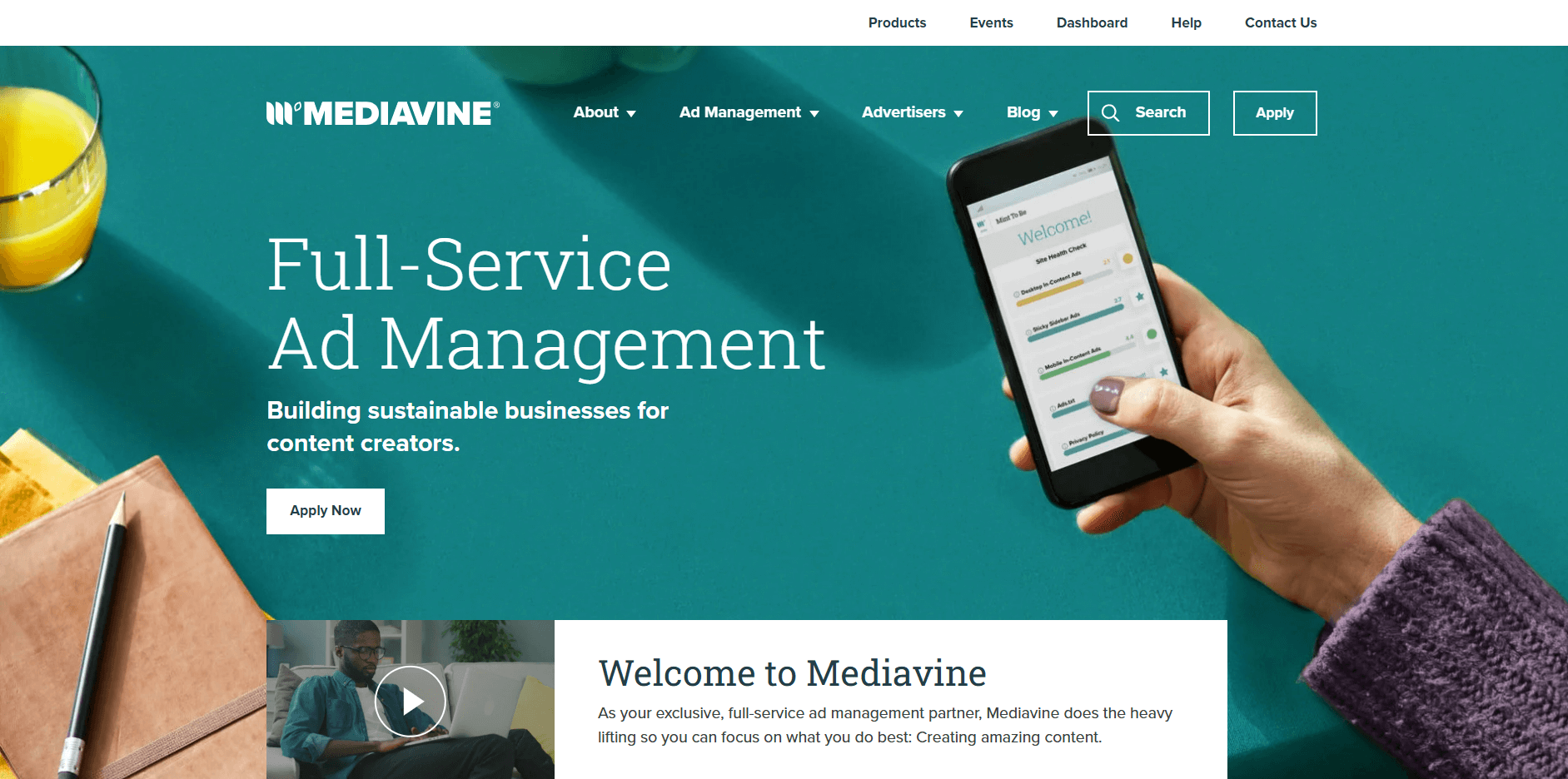
Mediavine is a popular premium ad management platform. It focuses on lifestyle content creators such as food, DIY, parenting, and travel bloggers.
Mediavine uses advanced ad technology. With high RPMs, it ensures publishers can earn more from their content.
This is achieved while maintaining a great user experience. Unlike other networks, Mediavine requires publishers to have at least 50K monthly sessions, ensuring that only established websites gain entry.
Its tools focus on maximizing ad revenue through intelligent ad placement, speed optimization, and strong brand partnerships.
Mediavine is ideal for bloggers who prioritize earnings. It also excels in site performance. This makes it a strong contender in the mid-tier ad network category.
Features:
- Focus on lifestyle niches
- Minimum 50K monthly sessions
- Advanced ad management tools
- High RPM potential
- Speed-optimized ads
- Transparent revenue model
- Excellent publisher support
- Automatic updates and reporting
- Custom ad placements
- Strong brand partnerships
Pros:
- High RPMs for lifestyle content
- Great support team
- Advanced optimization tools
- Transparent payments
- User-friendly dashboard
- Speed-focused technology
- Long-term revenue growth
- Trusted by top bloggers
- Exclusive ad campaigns
- Strong brand relationships
Cons:
- 50K session requirement
- Limited niche focus
- Approval process takes time
- Strict content guidelines
- Not suitable for beginners
- Payment NET-65 (longer wait)
- Can reduce site speed if unoptimized
- Limited non-English support
- Setup requires technical help
- High competition among publishers
Ad Types & Payout:
- Ad Types: Display, video, native, rich media ads
- Payout: NET-65 terms, revenue share model
6. MonetizeMore – Revenue Optimization Platform

MonetizeMore is an ad optimization platform. It provides publishers with advanced tools to maximize revenue.
These include header bidding, ad ops management, and A/B testing. Unlike traditional ad networks, MonetizeMore acts as a service partner, handling everything from ad placement to compliance with Google policies.
Publishers must earn at least $1000 per month in ad revenue to qualify. This makes it a good choice for growing websites that want expert guidance.
With a focus on maximizing yield, MonetizeMore uses cutting-edge technology. It also partners with premium demand providers.
As a result, it helps publishers achieve higher CPMs and stable earnings. It’s best for mid-tier to large publishers looking for professional ad revenue management.
Publishers using MonetizeMore can earn 50-300% more revenue than with AdSense. AdSense is often seen as an entry point for new publishers. However, specialized networks can offer higher revenue. They also provide dedicated support.
Features:
- Full ad ops management
- Header bidding wrapper
- Policy compliance support
- Premium demand partners
- Real-time analytics
- Advanced A/B testing
- Google Certified Publishing Partner
- Revenue optimization consulting
- High CPM potential
- Dedicated publisher support
Pros:
- Professional ad ops services
- Access to premium advertisers
- Advanced header bidding tech
- Improved CPMs and RPMs
- Compliance support
- Transparent reporting
- Dedicated account managers
- Strong optimization features
- Boosts revenue stability
- Suited for scaling publishers
Cons:
- $1000 minimum monthly revenue
- Not for small publishers
- Setup may be complex
- Requires ad revenue history
- Limited niche flexibility
- Can be expensive (revenue share)
- Slower onboarding process
- Dependence on MonetizeMore’s team
- Requires strong traffic consistency
- Competition for premium demand
Ad Types & Payout:
- Ad Types: Display, header bidding, native ads
- Payout: NET-30 to NET-60, revenue share model
Accessible Networks (Low Entry Barriers)
These ad networks offer easy setup. They have no minimum traffic requirements. The diverse ad formats make them ideal for beginners. They are perfect for small publishers seeking quick and flexible monetization options.
7. Adsterra – Global Reach Leader
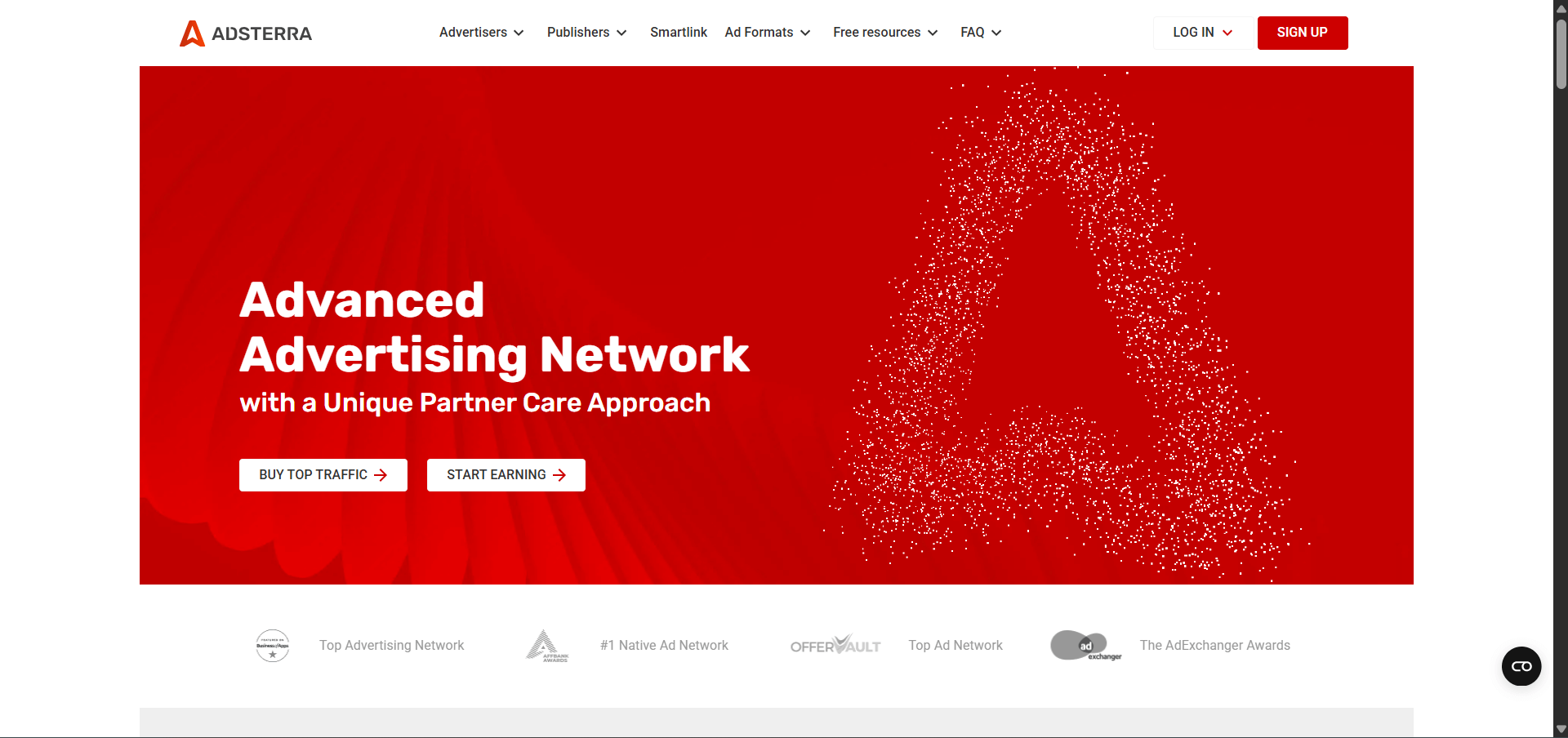
Adsterra is a popular global ad network known for its wide coverage across 248+ countries and territories.
It offers multiple ad formats. These include display, native, popunders, push notifications, and more. This makes it highly versatile for different types of publishers. Unlike premium networks with strict entry requirements, Adsterra has no minimum traffic requirement, which makes it beginner-friendly.
It also provides an intuitive dashboard, anti-fraud protection, and flexible payment options with a low $5 threshold.
With fast-growing global demand, Adsterra helps publishers monetize traffic from any region. Its reliability makes it stand out. It offers a wide ad format selection. The low entry barrier makes it one of the most accessible AdSense alternatives in 2025.
Features:
- Works in 248+ countries
- Multiple ad formats (display, pop, push, native)
- No minimum traffic requirement
- User-friendly publisher dashboard
- Advanced anti-fraud system
- High CPM rates for tier-1 traffic
- Real-time reporting
- Flexible targeting options
- Multiple payment methods
- Low payout threshold ($5)
Pros:
- Global reach with wide coverage
- Beginner-friendly with no entry barriers
- Fast approval process
- Supports multiple ad formats
- Reliable payouts
- Anti-fraud protection ensures safe monetization
- Works well with low or medium traffic sites
- Low payment threshold
- Great for non-English sites too
- Frequent promotions and bonuses
Cons:
- Popunders may affect user experience
- Lower CPM for tier-3 traffic
- Can slow down websites if overloaded
- Some formats may feel intrusive
- Ads not always brand-safe
- Limited premium advertiser demand
- Dashboard may feel basic for advanced users
- Inconsistent RPMs across geographies
- Heavy reliance on global traffic
- Lack of dedicated account managers for small publishers
Ad Types & Payout:
- Ad Types: Display, popunder, native, push notifications
- Payout: $5 minimum, weekly/NET-15 via PayPal, BTC, WebMoney, Paxum
8. PropellerAds: Push Notification Pioneer
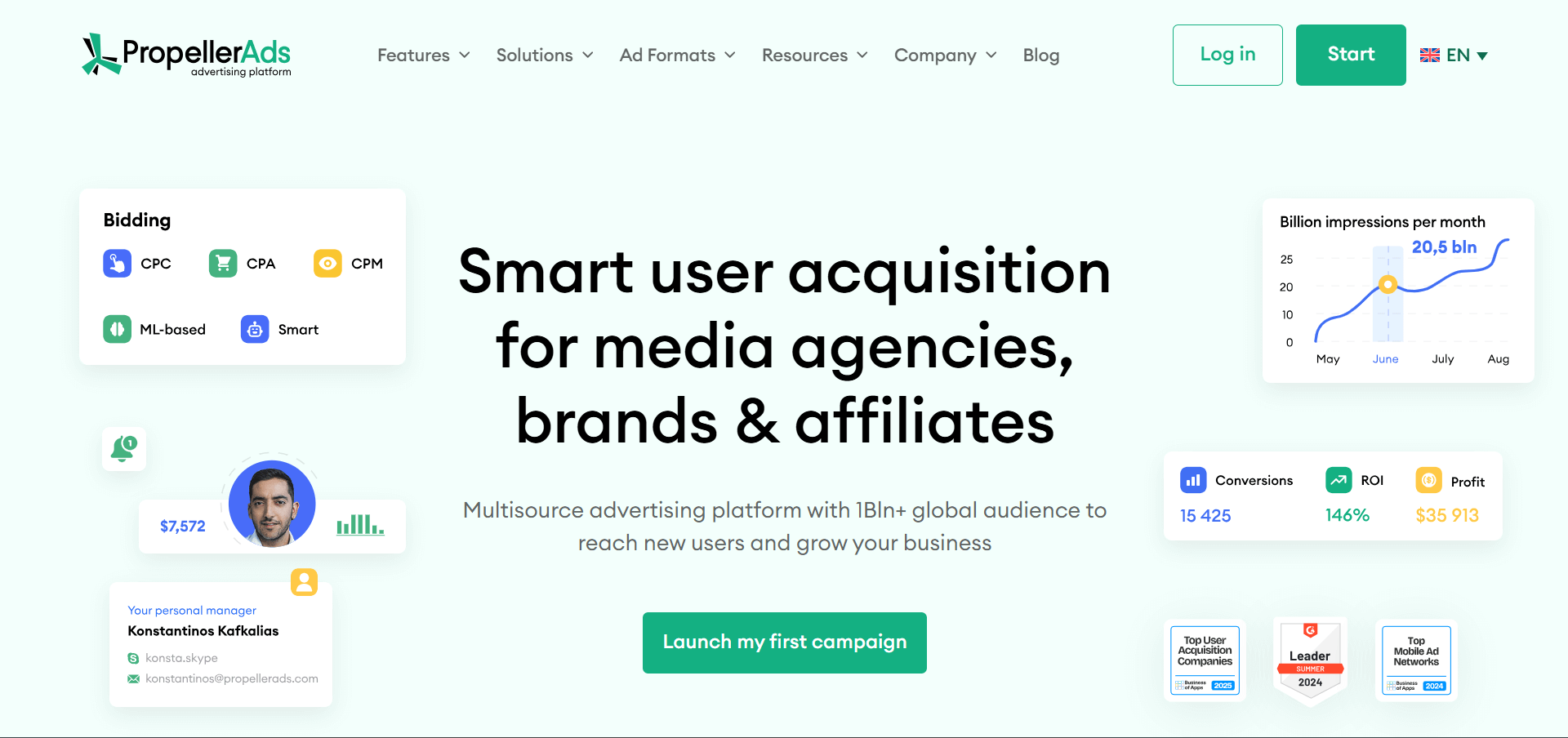
PropellerAds is one of the most accessible ad networks and a pioneer in push notification advertising. With global reach, PropellerAds accepts all types of traffic. It is ideal for small to medium publishers looking to monetize quickly.
It offers ad formats such as push notifications, popunders, native ads, and in-page push. The platform is easy to use and provides automated optimization tools for better performance.
PropellerAds offers a very low minimum payout of $5. It also provides multiple withdrawal options. It is well-suited for publishers who need flexibility and fast payments.
It’s a strong AdSense alternative for bloggers and site owners who want easy entry and consistent monetization. This is
Features:
- Push notification ads pioneer
- Global traffic acceptance
- Simple integration process
- AI-powered optimization
- Multiple ad formats
- Anti-fraud systems
- Instant account approval
- Flexible targeting
- In-page push option for mobile
- Multiple payout options
Pros:
- Beginner-friendly with no entry barriers
- Very low $5 payout threshold
- Fast account approval
- Strong in push ads performance
- Wide range of ad formats
- Reliable payouts weekly
- AI optimization improves RPM
- Accepts global traffic
- Simple dashboard
- Good for small publishers
Cons:
- Popunders may annoy visitors
- Lower CPM for non-tier-1 traffic
- Ads can look intrusive
- Limited premium advertisers
- Push ads may not suit all niches
- Requires higher traffic for big revenue
- Lower RPM compared to premium networks
- Limited brand safety filters
- May affect user experience on content sites
- Payment options vary by region
Ad Types & Payout:
- Ad Types: Push notifications, popunder, native, in-page push
- Payout: $5 minimum, NET-7/NET-30 via PayPal, WebMoney, Payoneer
9. Infolinks – In-Text Advertising
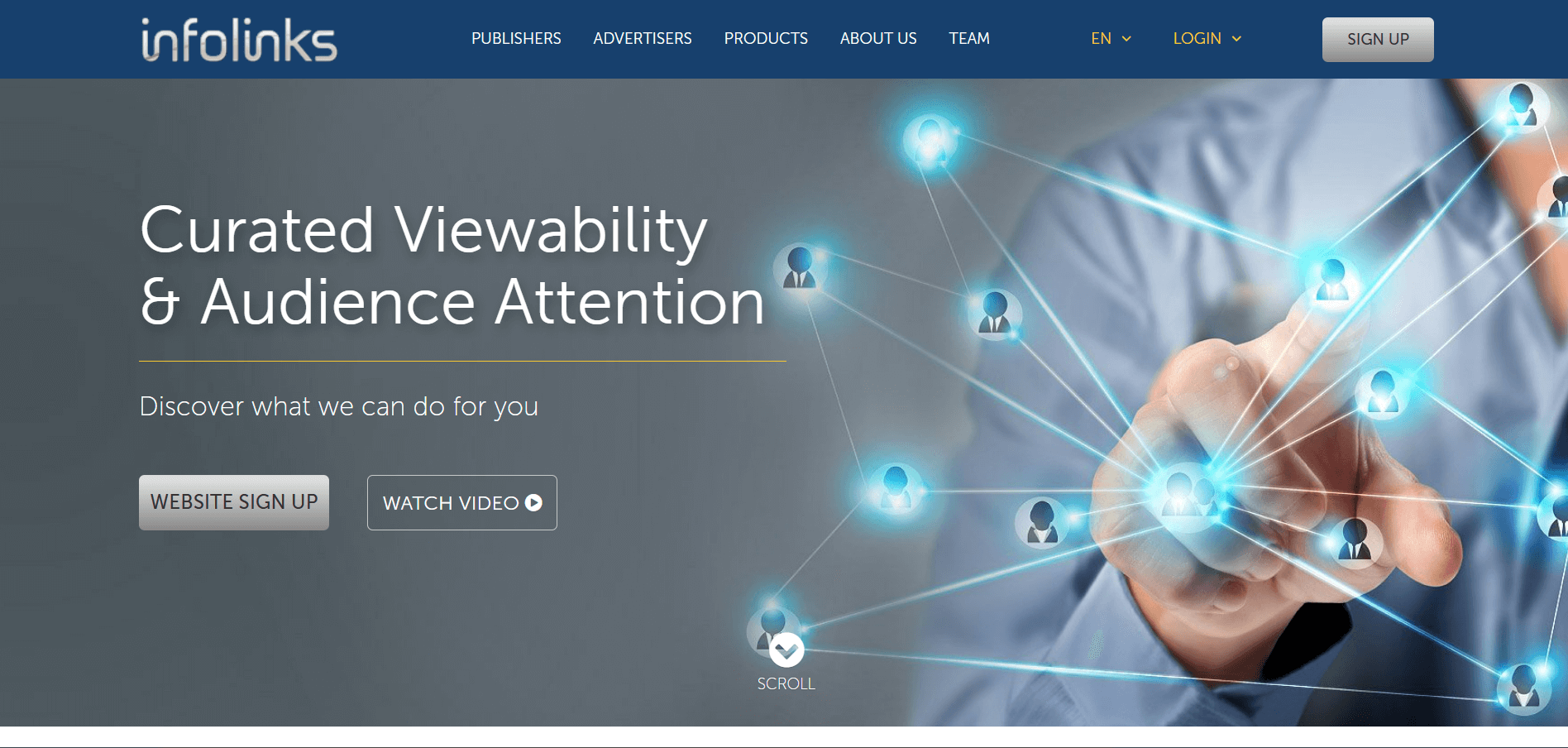
Infolinks is a unique ad network that specializes in in-text contextual advertising. Instead of relying solely on display ads, it uses keywords within your content to create monetized links.
These links display relevant ads when hovered over. This makes it a non-intrusive monetization method that works well alongside other networks, including AdSense.
With simple JavaScript integration, Infolinks is easy to set up and does not require a minimum traffic threshold.
It offers global coverage. The ad units are customizable. Its strong compatibility makes it a great option for publishers.
This is particularly true for those who want to add an additional revenue stream. Infolinks is especially useful for blogs, news websites, and content-driven platforms.
Features:
- In-text contextual ads
- Simple JavaScript integration
- Works alongside AdSense
- No minimum traffic requirements
- Customizable ad units
- Non-intrusive monetization
- Global advertiser network
- Real-time reporting dashboard
- Quick approval process
- Compatible with mobile and desktop
Pros:
- Non-intrusive ad format
- Works with AdSense together
- Beginner-friendly integration
- Accepts websites of all sizes
- Global ad coverage
- Customizable design
- Transparent reporting
- Easy setup and approval
- Good for content-heavy sites
- Enhances earnings without disrupting UX
Cons:
- Lower earnings than display ads
- Relies heavily on text-based content
- Some users find in-text ads distracting
- Not suitable for image-heavy sites
- Limited brand control
- RPM varies widely by niche
- May require testing for optimal placement
- Lower CPMs compared to premium networks
- Fewer ad format options
- Slower growth for small publishers
Ad Types & Payout:
- Ad Types: In-text, in-frame, in-fold, in-tag ads
- Payout: $50 minimum, NET-45 via PayPal, Payoneer, wire transfer
10. Bidvertiser – Pay-Per-Click Focus

Bidvertiser is a PPC-focused ad network that provides publishers with a straightforward way to monetize their websites.
It works by displaying ads based on both contextual and behavioral targeting, ensuring relevance to users. Unlike networks that rely on impressions alone, Bidvertiser emphasizes clicks, making it a performance-driven platform.
It also allows publishers to place bidding-based ads, which means advertisers compete for placements.
With no minimum traffic requirement, Bidvertiser is open to all publishers and offers a flexible monetization model.
Though CPMs can be lower, it’s a useful entry-level option for publishers wanting to explore pay-per-click alternatives to AdSense.
Features:
- PPC-based revenue model
- Behavioral and contextual targeting
- No traffic requirement
- Flexible ad formats
- Real-time reporting
- Self-serve advertiser bidding system
- Support for mobile ads
- Multiple ad customization options
- Fast approval process
- Low payout threshold
Pros:
- Accepts publishers of all sizes
- PPC model can be rewarding
- Simple setup and approval
- Supports mobile traffic
- Real-time analytics
- Multiple ad formats available
- Low entry barrier
- Fast payouts
- Reliable tracking system
- Beginner-friendly
Cons:
- Lower CPMs compared to premium networks
- Heavy reliance on clicks for revenue
- Lower advertiser demand in some niches
- Earnings inconsistent with low traffic
- Limited premium ad inventory
- PPC model may frustrate low-CTR sites
- Lower fill rates in certain regions
- Not ideal for brand-sensitive sites
- Ads may appear generic
- Slower growth compared to contextual ads
Ad Types & Payout:
- Ad Types: PPC ads, display, mobile ads
- Payout: $10 minimum, NET-30 via PayPal, wire transfer
Emerging and Specialized Networks
Explore innovative ad networks like Microsoft pubCenter, Snigel, and Amazon Publisher Services. They offer advanced monetization and premium advertisers. These networks use AI-driven optimization to boost your ad revenue beyond traditional options.
11. Microsoft pubCenter – Search Giant’s Alternative

Microsoft pubCenter is the company’s alternative to Google AdSense, offering publishers an opportunity to monetize traffic with Bing-powered contextual ads. After re-launching with broader support, pubCenter is expanding in 2025.
It will become a reliable choice for publishers. They seek high-quality ads from Microsoft’s vast advertiser base.
It integrates seamlessly with Bing search and Microsoft’s advertising network, giving access to premium demand.
While still rolling out in many countries, it offers competitive CPC rates for U.S. and U.K. publishers. Microsoft pubCenter has an easy setup. It features transparent reporting and strong brand advertiser backing.
This makes it a promising AdSense alternative for content creators who want search-integrated monetization.
Features:
- Powered by Microsoft Advertising (Bing)
- Expanding global availability
- Competitive CPC rates
- Contextual ad targeting
- Seamless Bing search integration
- Transparent analytics
- Easy integration and setup
- Premium advertiser demand
- Support for multiple formats
- Reliable publisher payments
Pros:
- Backed by Microsoft’s ad network
- High-quality contextual ads
- Great CPC rates in tier-1 countries
- Transparent payment process
- Strong advertiser demand
- Easy to set up for beginners
- Works well with U.S. and U.K. traffic
- Expanding availability in 2025
- Search integration adds value
- Reliable tracking and reporting
Cons:
- Limited availability worldwide
- Smaller advertiser base than Google
- Slower expansion in tier-3 countries
- Fewer ad formats compared to others
- Requires quality content for approval
- Not as established as AdSense
- Relatively new to many markets
- Fewer optimization tools
- Can’t yet match Google’s fill rates
- Still improving publisher support
Ad Types & Payout:
- Ad Types: Contextual ads, search-integrated ads
- Payout: $100 minimum, NET-30 via direct deposit, PayPal
12. Snigel (formerly AdEngine)
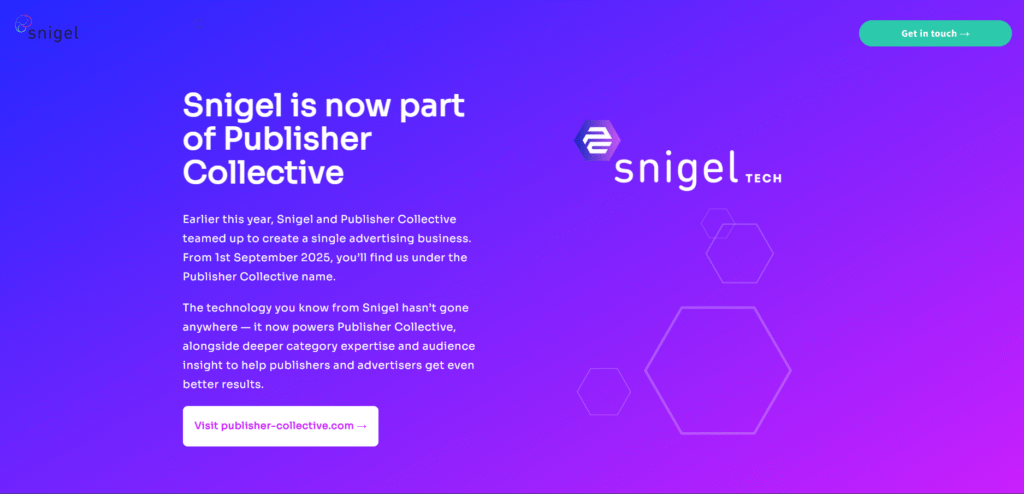
Snigel is a premium ad management platform that partners with Google through its MCM (Multiple Customer Management) program.
Known for its advanced monetization strategies, Snigel offers anti-adblock solutions, header bidding, and AI-driven optimization to maximize publisher revenue.
With a requirement of 50K monthly page views, it caters to mid- to large-size publishers. The platform provides hands-on account management, custom ad layouts, and real-time analytics for transparency.
Snigel’s technology-driven approach helps publishers improve CPMs while maintaining user experience.
For content-heavy sites with significant traffic, Snigel is a powerful AdSense alternative that combines expertise, technology, and dedicated support.
On average, publishers see a 57% revenue increase when switching from AdSense to Snigel.
Features:
- Google MCM partner
- Header bidding wrapper
- AI-based optimization
- Anti-adblock technology
- Real-time analytics
- Dedicated account managers
- Custom ad layouts
- Advanced targeting
- Focus on higher CPMs
- Transparent reporting
Pros:
- Strong partnership with Google
- Premium advertiser access
- Improves CPMs significantly
- Anti-adblock increases revenue
- Tailored ad layouts for each site
- Dedicated account support
- Works with multiple ad formats
- Real-time reporting for transparency
- Advanced header bidding solution
- Ideal for larger publishers
Cons:
- Requires minimum 50K monthly views
- Not beginner-friendly
- Complex setup for small publishers
- Higher barrier to entry
- Premium focus may exclude small blogs
- Approval can take time
- Heavier scripts may affect site speed
- No instant approval
- Limited availability for niche sites
- More suited for established publishers
Ad Types & Payout:
- Ad Types: Display, native, video, programmatic ads
- Payout: NET-30, threshold varies (bank transfer, PayPal)
13. Amazon Publisher Services (APS)
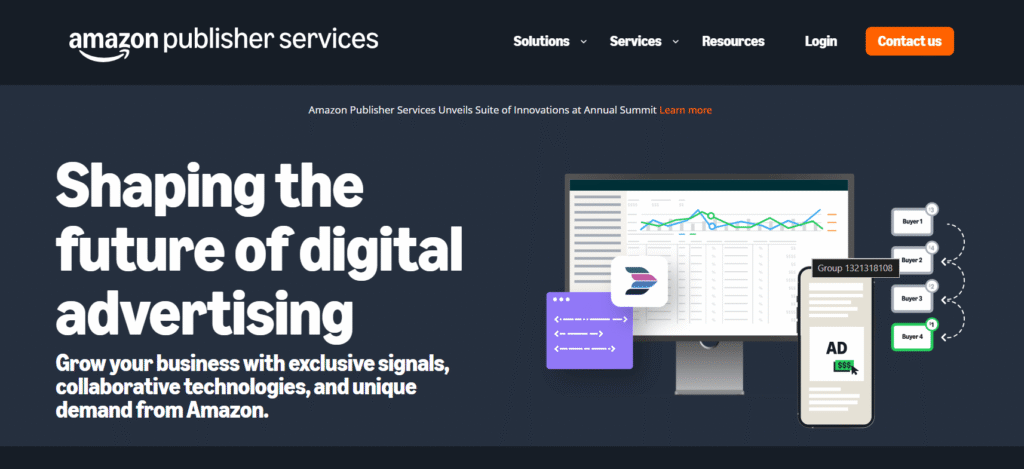
Amazon Publisher Services (APS) is Amazon’s premium advertising solution for publishers. It gives access to its vast network of advertisers and shoppers.
APS integrates directly with publisher ad servers and works seamlessly with header bidding. One of the key benefits of APS is the demand from Amazon’s advertisers. This demand ensures competitive bids. It also ensures high fill rates.
Publishers can also leverage Amazon’s shopper intent data to deliver relevant ads to their audience. APS is mainly accessible to mid- and large-scale publishers. It offers strong revenue potential. This is especially true for websites in retail, product reviews, and e-commerce niches.
Features:
- Backed by Amazon Advertising
- Seamless ad server integration
- Header bidding support
- Access to Amazon advertisers
- Shopper intent data targeting
- High fill rates globally
- Transparent bidding process
- Works with multiple formats
- Strong demand for retail niches
- Real-time reporting
Pros:
- Powered by Amazon’s advertiser base
- Competitive CPMs and CPCs
- Strong targeting with shopper data
- Reliable fill rates
- Works well with e-commerce content
- Premium demand across niches
- Scales with large publishers
- Transparent reporting
- High trust factor with advertisers
- Seamless header bidding integration
Cons:
- Not accessible for small publishers
- Requires advanced setup
- Minimum traffic requirements not disclosed publicly
- Slower approval process
- Focused more on retail/e-commerce niches
- Limited beginner support
- Less flexibility for small bloggers
- Integration may require technical expertise
- Still growing globally
- Heavier competition in some niches
Ad Types & Payout:
- Ad Types: Display, native, programmatic, video
- Payout: NET-60, minimum varies (bank transfer, ACH)
14. Sovrn (formerly VigLink)

Sovrn is a hybrid monetization network that combines affiliate marketing with display advertising. Formerly known as VigLink, Sovrn specializes in turning commerce-related content into monetized affiliate links automatically.
It also offers display ad solutions, giving publishers dual revenue streams. Sovrn provides real-time analytics, programmatic demand, and integrations with leading e-commerce partners.
It’s particularly useful for content creators in niches like reviews, shopping guides, and product recommendations.
Sovrn has no strict traffic requirements. It is open to both small and medium publishers. They can blend affiliate and ad revenue in one platform.
Features:
- Affiliate + display monetization
- Automatic affiliate link insertion
- Programmatic ad demand
- Easy integration
- Commerce-focused content monetization
- Dual revenue streams
- Real-time analytics
- Strong e-commerce partnerships
- Supports small publishers
- Flexible setup
Pros:
- Combines affiliate + display revenue
- Beginner-friendly setup
- Works with commerce-heavy content
- Opens up dual income opportunities
- No strict entry requirements
- Strong for review/product sites
- Auto-linking saves time
- Transparent reporting
- Accepts smaller publishers
- Good niche diversification option
Cons:
- Affiliate earnings vary by niche
- Lower CPMs than premium networks
- Requires commerce-related content
- Limited brand control over ads
- Affiliate links may feel intrusive
- Slow growth for non-shopping niches
- Some advertisers restricted by region
- Approval can take a few days
- Performance depends on CTR and conversions
- Limited customization of affiliate links
Ad Types & Payout:
- Ad Types: Affiliate links, display ads, programmatic
- Payout: $50 minimum, NET-30 via PayPal, ACH
15. FatAds – AI-Powered New Entrant
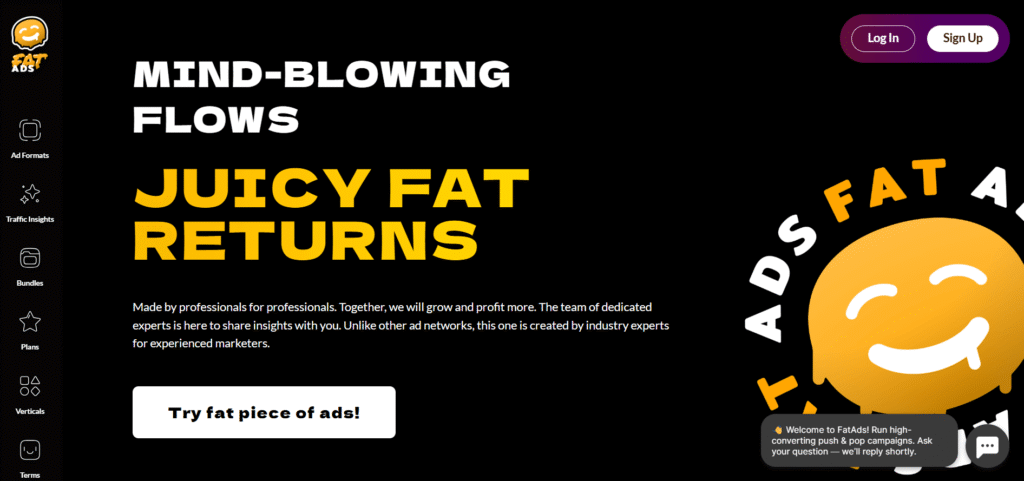
FatAds is an emerging AI-powered ad network launching in 2025, built around machine learning optimization and real-time bidding.
Unlike traditional ad networks, FatAds leverages artificial intelligence to maximize CPMs and improve targeting accuracy.
It’s designed to compete with established players by offering competitive rates and innovative monetization solutions.
With real-time analytics, lightweight integration, and AI-driven ad placement, FatAds is a forward-looking AdSense alternative for tech-savvy publishers.
Although still in its early stage, the network shows promise for both medium and large publishers looking for new opportunities.
Features:
- AI-powered monetization engine
- Machine learning optimization
- Real-time bidding system
- Modern ad placement solutions
- Lightweight integration
- Competitive launch rates
- Advanced targeting options
- Real-time analytics
- Designed for scaling publishers
- 2025 market entrant
Pros:
- Innovative AI-driven approach
- Competitive CPMs for early adopters
- Future-proof technology
- Lightweight code for faster pages
- Transparent reporting
- Flexible ad formats
- Early adoption advantage
- Strong focus on optimization
- Designed to scale with publishers
- Unique positioning in ad tech space
Cons:
- New network with limited history
- Unproven long-term stability
- Limited advertiser demand at launch
- Availability restricted to select publishers initially
- Support system still developing
- Approval process details unclear
- Risk of lower fill rates early on
- May not suit very small publishers
- Limited community feedback yet
- Continuous updates expected post-launch
Ad Types & Payout:
- Ad Types: Display, native, programmatic, AI-optimized ads
- Payout: Details emerging, expected NET-30 with flexible thresholds
How to Choose the Right AdSense Alternative
Choosing the best AdSense alternative for your website or blog is crucial. It maximizes your advertising revenue and improves user experience.
With so many options available, it’s important to evaluate each alternative carefully based on your website’s unique characteristics and goals. This section outlines key selection criteria and a readiness assessment to help you make an informed decision.
Key Selection Criteria
1. Traffic Requirements
- Different ad networks and platforms have varying minimum traffic requirements.
- Some premium networks require high monthly page views.
- This is often 50,000 or more to qualify. Others welcome smaller or newer websites with no minimum thresholds.
- Consider not only the quantity but also the quality and geographic location of your traffic.
- Certain ad networks perform better with traffic from Tier 1 countries like the US, UK, and Canada. Other networks offer more global reach.
- Aligning your traffic profile with the network’s strengths can significantly impact your ad revenue.
2. Revenue Factors
- Evaluate the potential earnings based on CPM rates, which vary by region, niche, and ad format.
- Payment thresholds and schedules differ across platforms, so ensure the payout terms fit your cash flow needs.
- Also, compare revenue sharing models—some networks offer higher percentages to publishers than Google AdSense, which typically takes a substantial cut.
- Understanding these financial details helps you estimate your true earnings potential.
3. Technical Integration
- Consider the complexity of implementing the ad network on your site.
- Some platforms offer easy integration via a self-serve platform or plugins. Others may require adding code snippets.
- You might also need to manage header bidding setups.
- Mobile optimization is critical, as a growing portion of traffic comes from mobile devices.
- Additionally, assess the impact of ads on your site’s loading speed and overall performance to maintain a positive user experience.
4. Support and Reliability
- Reliable support can make a big difference, especially if you encounter issues with your ad setup or payments.
- Look for networks that provide dedicated account management, quick response times, and stable platforms with minimal downtime.
- A trustworthy partner helps ensure consistent revenue generation and peace of mind.
Publisher Readiness Assessment
Before applying to an ad network, conduct a self-evaluation to ensure your website meets the necessary criteria:
- Traffic Quality: Verify that your traffic is organic and complies with the network’s policies to avoid invalid traffic penalties.
- Content Compliance: Ensure your content aligns with the ad network’s guidelines, avoiding restricted or prohibited topics.
- Technical Preparedness: Confirm that your website supports the required ad formats and integration methods.
- Monetization Goals: Define clear objectives for your ad revenue, user experience balance, and long-term growth.
Thoroughly assess these factors. You can select an AdSense alternative that aligns with your website’s profile. This maximizes your ad revenue potential while maintaining a high-quality user experience.
Revenue Potential by Traffic Level
Understanding how different ad networks perform based on your website’s traffic volume is crucial. It helps you choose the best AdSense alternatives. This ensures you maximize your ad revenue effectively.
1. Low Traffic Sites (Under 10K monthly)
- For website owners with lower traffic volumes, choosing the right adsense alternatives is crucial to maximize revenue.
- Networks like Adsterra, PropellerAds, and Infolinks are ideal for these publishers and advertisers. They offer easy integration.
- There are no minimum traffic requirements.
- These platforms focus on volume over premium rates, with expected CPMs ranging from $0.10 to $0.50. They support various ad formats.
- These include display ads, popunder ads, and in-text contextual ads.
- These formats help small publishers add display ads effectively to their sites. Publishers can start generating revenue quickly.
2. Medium Traffic Sites (10K-100K monthly)
- Publishers with moderate traffic can benefit from more sophisticated ad networks such as Ezoic, Media.net, and Sovrn.
- These platforms provide access to multiple ad exchanges and premium advertisers, enabling a balance between entry requirements and revenue potential.
- Expected CPMs typically range from $0.50 to $2.00. These ad networks support multiple ad formats. Formats include native ads, video ads, and push notifications.
- This variety allows publishers to implement a customized ad strategy. Such a strategy enhances user experience while boosting ad revenue.
- Additionally, many of these networks are Google Certified Publishing Partners, ensuring high ad quality and compliance with policies.
3. High Traffic Sites (100K+ monthly)
- High-traffic websites have access to premium tier networks like Setupad, Raptive, and Mediavine.
- These networks offer advanced programmatic advertising solutions. They also provide header bidding technology.
- These networks connect publishers to multiple ad exchanges. They include exclusive access to Google Ad Exchange.
- This connection ensures maximum competition for ad space. It results in higher CPMs, often exceeding $2.00 to $5.00 or more.
- They offer various ad formats. These include interactive ad units, social media ads, and video ads. This range enables publishers to optimize ad placements strategically.
- These platforms offer comprehensive support.
- They offer custom ad optimization strategies.
- Their advanced analytics help maximize advertising revenue. The platforms maintain a positive user experience, even with ad blockers enabled.
Getting Started with Multiple Networks
Entering the world of online advertising can be overwhelming, especially with the plethora of ad networks available.
To maximize your website’s revenue potential and maintain stability, many publishers choose to work with multiple ad networks simultaneously.
This approach not only diversifies income streams but also helps optimize ad performance by leveraging the strengths of different platforms.
In this section, we’ll guide you through the essentials of starting with multiple ad networks. We cover strategies for effective portfolio diversification.
There are also technical implementation tips to ensure a seamless user experience.
1. Portfolio Diversification Approach
- To maximize your advertising revenue and reduce risk, it’s wise to run 2-3 ad networks simultaneously.
- This diversification approach allows you to test which networks perform best for your site’s audience and content.
- By A/B testing different ad placements across these networks, you can identify the optimal positions.
- These positions generate the highest click-through rates and revenue. Diversifying your revenue sources is crucial.
- It protects you from sudden account suspensions or policy changes with any single network. This ensures steady income streams.
2. Technical Implementation
- Setting up multiple ad networks requires careful technical implementation to maintain site performance and user experience.
- Start by grasping the basics of header bidding. It is a method that allows multiple demand sources to bid on your ad inventory simultaneously.
- This increases competition and CPMs. Optimize your ad placements by balancing visibility with non-intrusiveness, placing ads where they attract attention without disrupting content flow.
- Additionally, monitor your site’s loading speed closely. Use lazy loading and asynchronous ad scripts.
- This ensures ads do not slow down your website and preserves a smooth browsing experience for visitors.
3. Ad Quality and Control
- When choosing an AdSense alternative, ad quality and control should be at the top of your checklist.
- High-quality ads not only protect your brand reputation but also drive higher click-through rates and, ultimately, greater ad revenue.
- Leading ad networks like MonetizeMore invest heavily in advanced ad tech. They offer features such as invalid traffic blocking.
- They also provide AI-powered header bidding. These technologies ensure that only relevant, engaging, and safe ads appear on your site.
- This reduces the risk of spammy or intrusive content. Such content could harm user experience.
Granular control over ad placements and formats is another key advantage of many AdSense alternatives. The best platforms let you decide exactly where ads appear. You can choose which ad formats to use. They allow you to control how aggressively to target your audience. This level of customization allows you to fine-tune your ad strategy, balancing revenue generation with a seamless user experience. Prioritize ad quality to keep your audience engaged. Maintain control over your ad setup to maximize your ad revenue. This approach ensures your audience stays satisfied.
4. Ad Formats and Diversity
- Most ad networks support basic ad formats, including banner ads, which remain a popular choice for visual advertising on websites.
- The variety of ad formats offered by an AdSense alternative can significantly impact your site’s ad revenue.
- It can also enhance user engagement. Unlike the limited options available with some networks, top AdSense alternatives like Media.net and PropellerAds offer a broad range of ad formats.
- These include display ads, native ads, video ads, push notifications, and popunder ads.
- This diversity allows publishers to experiment with different ad strategies and find the most effective combinations for their unique audience.
- For example, native ads blend seamlessly with your content. They enhance user experience and boost engagement. Video ads and push notifications can capture attention.
- They also drive higher CPMs. Some platforms, such as Connatix, specialize in native video ads.
- They are the best AdSense alternative for publishers focused on video content. Others, like PopAds, excel in popunder ads, which can be highly effective for certain niches.
- By using a mix of ad formats—including interactive and emerging types—you can optimize your ad placements. This approach increases user engagement. It also unlocks new revenue streams.
5. Payment Terms and AdSense Alternatives
- Understanding payment terms and revenue sharing models is essential when evaluating AdSense alternatives. Each ad network sets its own minimum payout thresholds.
- They have different payment schedules.
- Revenue share percentages vary too. All these factors directly impact your ad revenue and cash flow.
- For example, Google AdSense requires a $100 minimum payout. Some alternatives, like PopAds, have much lower thresholds.
- These lower thresholds allow you to access your earnings faster.
- Additionally, revenue sharing models can vary widely.
- Platforms like BuySellAds often let publishers retain a larger portion of the ad revenue compared to AdSense.
- This retention can significantly boost your bottom line over time. It’s important to review these terms carefully to ensure they align with your financial goals and payment preferences.
- Selecting an AdSense alternative with favorable payment terms is crucial. A transparent revenue share helps to maximize your ad revenue. It also ensures you maintain a steady income stream.
6. AdSense Alternative Metrics and Tracking
- To optimize your ad revenue, you need access to robust metrics. You also need tracking tools provided by your chosen AdSense alternative.
- Comprehensive analytics allow you to monitor ad earnings, click-through rates, and other key performance indicators in real time.
- This data-driven approach helps you identify the most effective ad strategies and placements.
- It enables you to make informed decisions that boost your overall ad revenue.
- Many leading AdSense alternatives, such as Monumetric and Setupad, offer advanced reporting dashboards and A/B testing capabilities.
- These features empower publishers to experiment with different ad formats, placements, and targeting options, refining their approach for maximum results.
- By leveraging detailed metrics and continuous tracking, you can stay ahead of trends.
- You can quickly address underperforming ad units. This strategy ensures your ad earnings are always optimized.
User Experience and AdSense Alternatives
- User experience is a critical factor when integrating AdSense alternatives into your website.
- Poorly placed or overly intrusive ads can frustrate visitors, increase bounce rates, and ultimately reduce your ad revenue.
- The best AdSense alternatives prioritize user experience.
- They offer customizable ad formats and flexible placements.
- These features allow you to seamlessly blend ads with your site’s design and content.
- Platforms like AdRecover specialize in serving non-intrusive ads to users with ad blockers enabled.
- This helps you monetize an otherwise unreachable segment of your audience.
- Focus on ad formats that are relevant and well-integrated.
- Such formats include native ads, video ads, and responsive display ads. This way, you can maintain a positive user experience.
- You can still maximize your ad revenue. Remember, a satisfied audience is more likely to engage with your content.
- They are also more likely to engage with the ads you display. This creates a win-win scenario for both revenue generation and long-term site growth.
Advanced Monetization Techniques
In the competitive world of online publishing, you can leverage advanced monetization techniques. These techniques can significantly enhance your ad revenue.
They also diversify your income streams. This section presents innovative strategies and hybrid models. These go beyond traditional ad placements.
They help you maximize earnings while maintaining a great user experience.
1. Hybrid Monetization Models
- Many website publishers now combine multiple revenue streams to maximize ad revenue by creating hybrid monetization models.
- These hybrid models go beyond traditional display ads.
- One effective approach is integrating affiliate marketing niche strategies alongside display ads.
- This setup allows publishers to earn commissions through affiliate links. They also benefit from AdSense ads or other ad formats displayed on their site.
- Example: Incorporating Amazon native shopping ads within relevant content can boost both affiliate earnings and ad revenue.
- Email list building integration is another powerful tactic:
- Publishers can cultivate a targeted email list and promote products, services, or exclusive offers directly to engaged users.
- This approach complements ad monetization efforts.
- Additionally, product placement opportunities within content or sponsored posts can provide an extra revenue stream without compromising user experience.
2. Optimization Best Practices
- Optimizing ad placements is crucial for boosting ad earnings while maintaining a positive user experience.
- Heat map analysis tools help publishers identify high-visibility areas on their pages. These are spots where AdSense ads and other ad units can perform best.
- Tracking mobile vs. desktop performance ensures ad formats and placements are tailored for different devices, considering the increasing share of mobile traffic.
- Seasonal trend adaptation strategies play a key role:
- Advertisers often increase bids during peak seasons or major events.
- Adjusting ad setups to align with these periods can help maximize revenue.
- A customized ad strategy leverages seasonal trends and user behavior to optimize ad revenue effectively.
- These approaches also enhance overall user engagement throughout the year.
Common Mistakes to Avoid
1. Network Selection Errors
- When choosing from various AdSense alternatives, many website owners make a common mistake. They often select a network solely based on payment terms.
- While favorable payout schedules and low minimum traffic requirements are important, they should not be the only factors considered.
- Ignoring geographic targeting can lead to suboptimal ad revenue:
- Some ad networks perform better with traffic from Tier 1 countries.
- Others specialize in global or Tier 3 markets.
- Overlooking policy restrictions can result in account suspensions.
- Ignoring content compliance guidelines may reduce ad quality.
- These issues can negatively impact both your advertising revenue and user experience.
2. Implementation Pitfalls
- Over-monetizing your website can degrade user experience. Too many ads or intrusive ad formats can increase bounce rates.
- It is essential to balance revenue generation with maintaining a positive user experience.
- Neglecting mobile optimization is another common mistake:
- Mobile traffic now comprises a significant portion of website visitors.
- Ensuring your ad placements and ad formats are mobile-friendly—including native ads and video ads—is crucial for maximizing earnings.
- Insufficient performance tracking and lack of a custom ad optimization strategy can prevent publishers from fully optimizing ad revenue:
- Use analytics to monitor various ad units.
- Experiment with different ad formats across multiple ad exchanges.
- These actions help refine your ad setup for better results.
- Be aware of ad blockers enabled by users. Select premium ad networks that provide anti-adblock solutions. These measures safeguard your revenue streams.
- Avoid these common mistakes and carefully select the best Google AdSense alternatives tailored to your website’s traffic and niche.
- By following these practices, you can boost your ad revenue while preserving a high-quality user experience.
2025 Industry Trends and Future Outlook
1. Emerging Technologies
- The digital advertising world in 2025 is changing rapidly. New technologies are revolutionizing how website owners earn more from their sites.
- Artificial intelligence (AI) is increasingly used to improve ads:
- AI studies user behavior in real-time and places ads tailored to users’ interests.
- This increases ad effectiveness and publisher earnings.
- Website owners can create adaptive ad strategies based on visitor preferences.
- Privacy has become crucial:
- Regulations like GDPR and CCPA require websites and ad networks to protect user data while maintaining relevant advertising.
- Contextual ads—where ads are shown based on the content of the page—are becoming more common.
- Asking for user permission before using data helps maintain user trust.
- Blockchain technology is emerging for ad payments:
- Payments to website owners are faster, safer, and more transparent using a secure digital ledger.
- Blockchain reduces fraud and builds trust between advertisers and publishers.
2. Market Predictions
- Larger ad networks are expected to merge with or acquire smaller, specialized platforms:
- Publishers will gain easier access to multiple ad exchanges and premium advertisers.
- Simpler interfaces will streamline ad setup processes, boosting revenue.
- CPM rates will likely rise, especially for video ads, native ads, and interactive ad units:
- Advertisers will prioritize high-quality ad spaces and positive user experience.
- Publishers offering diverse ad formats and premium placements will attract better bids and higher earnings.
- Mobile advertising will continue to grow as user mobile browsing increases:
- Both ad networks and publishers will improve mobile ad placements and formats for smooth experiences.
- Innovations like in-page push ads and mobile-friendly video ads will help maximize revenue from mobile users.
In summary, 2025 promises rapid change for website publishers. Embracing new technologies and adapting to market developments are key to increasing ad revenue and staying competitive in digital advertising.
Frequently Asked Questions
Can I use multiple AdSense alternatives on my website?
Yes, you can use several ad networks at the same time to increase your revenue and diversify income sources.
What is the minimum traffic requirement for most AdSense alternatives?
It varies. Some networks accept websites with no minimum traffic. However, premium networks may require 50,000 or more monthly page views.
Do AdSense alternatives pay more than Google AdSense?
Many alternatives offer higher payouts. This is especially true for specific niches or traffic from Tier 1 countries. However, results depend on your site and audience.
How long does it take to get approved by an AdSense alternative?
Approval times vary from instant to a few days or weeks, depending on the network and your website’s quality.
Are AdSense alternatives safe to use?
Yes, reputable alternatives follow strict policies and provide safe ad content, but always choose trusted networks to avoid issues.
Can I use AdSense alternatives alongside Google AdSense?
Yes, many publishers run multiple ad networks together to maximize ad revenue.
What types of ads do AdSense alternatives offer?
They offer various ad formats including display ads, native ads, video ads, popunder ads, and push notifications.
Will using AdSense alternatives affect my website’s user experience?
Good alternatives focus on balancing ad revenue with user experience, offering customizable and non-intrusive ad formats.
Do AdSense alternatives support mobile ads?
Yes, most networks provide mobile-optimized ads to ensure good performance on smartphones and tablets.
How do I choose the best AdSense alternative for my site?
Consider your traffic level, niche, ad format preferences, payout terms, and ease of integration to find the best fit.
Who is the highest paying AdSense alternative in 2025?
Setupad is considered the highest paying AdSense alternative in 2025. Many publishers report a significant boost in ad revenue, often 30% or more compared to Google AdSense. In premium niches, networks like Raptive (AdThrive) and Mediavine provide some of the highest payouts. This is especially true for sites with large US traffic and high-quality content.
Conclusion and Recommendations
For bloggers, website owners, and online publishers, it is essential to find the right AdSense alternatives in 2025. This helps them maximize ad revenue. While Google AdSense pay remains a popular choice, not every site qualifies.
Sometimes bloggers seek networks that offer better flexibility. They also look for opportunities for higher earnings. Platforms like Mediavine, Raptive, Adsterra, Media.net, MonetizeMore, and SetupAd provide excellent opportunities for monetizing blogs, whether through display ads, native ads, video ads, or pop-unders.
Choosing the right ad network for your niche is crucial. Whether it’s technology, lifestyle, finance, or health, the right choice increases CPM, CPC, and overall website earnings. Unlike AdSense, these networks can provide specialized ad formats, tailored optimization tools, and more personalized support.
Using these AdSense alternatives pay options can help you diversify income streams. They can also optimize ad placement. Additionally, they boost blog monetization while keeping your content user-friendly and SEO-friendly.
- BuySellAds is a marketplace for direct ad sales, connecting publishers with high-quality advertisers, leading to potentially higher CPMs.
- Publishers can sell ad space directly on their websites to advertisers, maximizing their earnings and bypassing intermediaries.
- BuySellAds allows publishers to set their own prices for ad inventory, providing greater control over income compared to AdSense.
- Amazon Associates is a popular affiliate program that allows users to earn commissions by promoting Amazon products through unique links.
- Infolinks offers a higher percentage of revenue to publishers than AdSense, retaining 65% for publishers.
- Skimlinks automates affiliate marketing by adding affiliate links to content mentions, benefiting review sites and niche blogs.
By carefully selecting networks based on traffic requirements, payout methods, and ad types, you can ensure a steady online income.
This way, you are not relying solely on Google AdSense. If you want to maximize website monetization in 2025, you should explore these best AdSense alternatives. It is the key to sustainable revenue growth for bloggers and publishers.

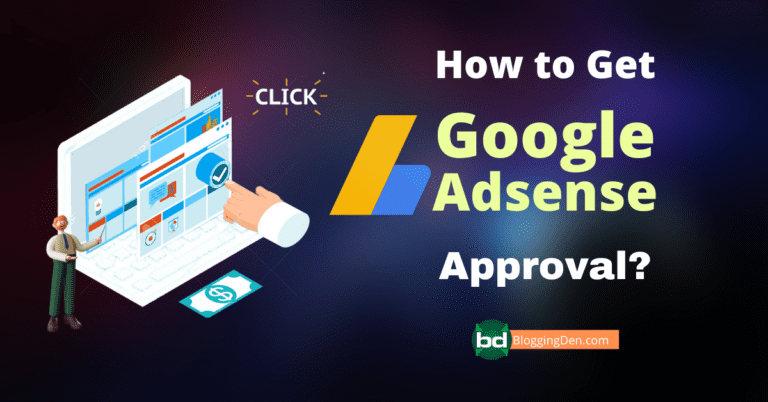
Hello Satish sir,
Nice article, I’ve been struggling for Google ads for God knows when but they keep turning down my request, I don’t know what exactly that I’m not doing right in my blog, please help me and check if everything is normal. I also tried applying for Yahoo ads (media.net) and they turned me down as well. Maybe I’ll try out the other ones you listed but not propellers ads because I dislike it.
Hello Gabriel,
I was checked your site. Few of the articles are violating to AdSense program policies.
1. Remove software download links and posts.
2. Remove VPN tools links.
3. Check this link to know the Adsense program policies: https://support.google.com/adsense/answer/48182?hl=en
Check your blog before applying to AdSense by following the AdSense program policies.
All the best
Hi Satish Sir,
Great post about Adsense alternative, I am a new blogger. I have created my blog on google blogger and published 3 original posts. now can I apply for Google Adsense please suggest me sir.
Hello Prosanta Mondal,
Getting Adsense approval is not an easy task. Write more quality articles like useful tutorials, reviews, lists, etc. Add Privacy Policy, Terms of services pages, and add more information in About page and Contact page (Your complete details). If your blog has more than 15 unique articles and minimum traffic, Google will enable an AdSense account.
All the best
Hi sathish.Thanks for the amazing article.My viewers are mostly frm US and UK ..which affiliate is best?
Hello MuthuKrishnan,
I checked your blog. It is good, clean, and responsive. The choosing of an affiliate program is completely your choice. What type of products you are willing to promote. Try ShareASale, Amazon.com, and ClickBank, these programs are working well for my blogs. These marketplaces are completely free. Just signup – activate your account and choose one or more products and promote on your blog.
Wish you all the best
Great, This is pretty Good, I was only aware of infolinks other than google adsense. And yes the problem you mention about google adsense is correct they do not approve each request. I tried a lot of times for my websites but i didnot get any success.
But now I ll try these alternatives lets see any success or not.
Thanks
Recently my blog got Adsense approval. But I am not getting good traffic.
Hello Prem,
Getting traffic to the blog is the biggest game in the blogging journey. Do not worry.
1. Write good and quality content,
2. post articles frequently
3. Share your post in relevant groups and communities
4. Do Off-SEO in a proper way like Blog commenting (daily 2-3), Guest post submission (1 post per month) and Participate forum activities.
5. inform about your latest posts to your readers through Email, messengers (Whatsapp and Facebook messengers).
You will get good traffic instantly.
All the best